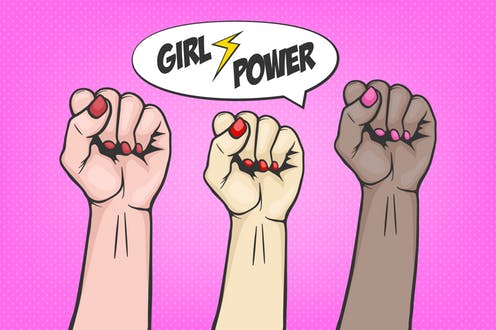Why feminism still matters to young people
It has been 100 years since women won the right to vote in Britain. More accurately, it’s 90 years since young women were able to vote; 2018 actually celebrates 100 years since suffrage was given to women over 30.
Feminism is held up as one of the most successful social movements of the 20th century. But ten years ago, when Catherine Redfern and I were planning our book on reclaiming feminism, some said young people just weren’t interested in “the f word” anymore.
Back in the 1990s and early 2000s, young women were portrayed smashing glass ceilings in Louboutin heels, and feminism seemed rather outmoded. Many women thought of themselves as post-feminist, feeling there was no need for feminism, since gender equality had been achieved. But this wasn’t really true, and a lot of the fear about calling yourself a feminist came from the negative stereotyping of feminists as bitter “killjoys”.
It’s still needed
Things have changed. Feminism is now less despised because it’s more obviously needed. Women in the UK have been living under a regime of austerity since the 2008 economic crisis. They have shouldered 86% of the income loss from changes to the tax and benefits systems since 2010, simply because they are more likely to be welfare recipients in the first place.
Meanwhile, the resurgence of the far right has led to violence and harassment against ethnic minority women, with Muslim women bearing the brunt of virulent Islamophobia. There is a stubborn gender pay gap (now 14% for full-time workers), and women pensioners in the UK face one of the worst gender income gaps in Europe.
The list goes on: gender-based violence is alarmingly high. Crime statistics show that one in four women, and one in seven men aged 16 to 59 have experience domestic abuse. The most harmful forms of abuse – sexual violence, especially – affect mostly women. Yet three-quarters of councils have cut funds to domestic violence services due to government budget cuts, and a third of referrals to refuges are now being turned away because of a lack of room.
It’s gaining popularity
These examples of gender inequality explain why more people are identifying as feminists – especially young women. A 2013 Girlguiding survey found that 35% of girls and young women aged 11 to 21 were happy to call themselves feminists. In 2017, this was the case for 43% of 18 to 34-year-old women, according to a poll by Plan International, or 54% of 18 to 24-year-old women, according to UM London.
Today’s feminist movement is more diverse than ever before. Feminism has become more attentive to the wider range of experiences of those oppressed by gender norms and stereotypes, including men, non-binary and trans people.
There’s also greater awareness of the way that racism, anti-religious hatred, disablism or homophobia work alongside sexism, creating complex forms of prejudice and oppression. It’s not so much that feminism has moved “beyond” sexism. Rather, a wider range of voices is now being counted as feminist. The HeForShe campaign, which encourages men to become advocates for gender equality, and Muslimah Media Watch, a forum where Muslim women critique how they are presented in the media and popular culture, are examples of this.
It’s already happening
If the current situation has anything positive to show, it’s that where there’s injustice, there’s also resistance. Young people are already challenging the forces feminist author bell hooks calls “white supremacist capitalist patriarchy” with style and skill – they don’t need to be told how by older feminists. What’s crucial now is to recognise the work they are doing and draw even more people to the cause.
Campaigns such as #TimesUp in the US and #tystnadtagning in Sweden have used the star power of famous actors – many of whom are young women – to draw a line under sexual harassment and abuse in the workplace, across all industries. Yet even worldwide movements can start with the actions of a single person: activist Tarana Burke has been credited with starting the #metoo movement more than ten years ago, based on her experiences as a youth camp director for Just Be Inc.
As these examples show, feminist activism takes many forms, from a single person signing a petition, to group protests on local issues such as the campaign to close Yarl’s Wood detention centre in Bedfordshire, right through to large-scale actions coordinated by women’s organisations, such as Women’s March. Feminist acts can be taken through formal political routes. For example, by lobbying a local member of parliament, or by informal means, such as sharing information about a topic on social media or boycotting a company known for exploiting women employees.
Individuals can make a difference by working for a women’s charity, becoming a local councillor or calling out sexual harassment wherever they encounter it. Even the conversations we have with our friends in our spare time can be a productive way to raise awareness about sexism.
There is no “right” form of activism and no one issue of greatest importance. A century ago, women’s rights activists weren’t all fighting for suffrage – some of them were working on other campaigns, such as equal access to university education, or a decent wage for working-class women. Nor did getting the vote solve other instances of gender injustice. So this 100-year anniversary is about much more than just “the vote”. Feminism is a movement for gender justice, and it needs to be fought by many different people, in many different ways.


